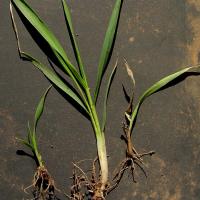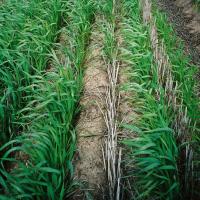Diagnosing poor seed-soil contact in crops
Poor seed soil contact describes situations where air around the sown seed prevents it from absorbing moisture from the soil. This is most often a problem in marginally wet seed beds.
What to look for
- Uneven germination and stunted plants that often occur along drill rows or specific soil types.
Paddock
- Smaller or stunted plants.
- Plants may have smaller root systems and be dying back from the older leaf.
Plant
What else could it be
| Condition | Similarities | Differences |
|---|---|---|
| Diagnosing deep seeding in cereals | Poor emergence and weak seedlings. | Plants sown too deep have longer coleoptile's. |
| Diagnosing allelopathy in cereals | Poor emergence and weak seedlings and is associated with plant residues close to the seed that can lead to poor seed-soil contact. | Root appearance - silly seedling shoots frequently wander through the soil without reaching the surface. |
Where did it come from?
- Poor seed soil contact from insufficient soil compaction or poor coverage of the seed in the seeding slot.
- Air around the sown seed prevents it from absorbing moisture from the soil.
- Seed sown on the soil surface.
- 'Hairpinning', where straw is pinned in the seeding slot, leaving air voids and increasing the risk of silly seedling.
Management strategies
- To ensure sufficient seed soil contact it is important the sowing machinery is designed to seed at a uniform depth and provides uniform soil cover.
- Systems such as harrows and prickle chains are subject to variations in the soil surface.
- Press wheels offer increased control.
Page last updated: Friday, 10 July 2015 - 3:34pm




